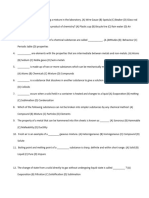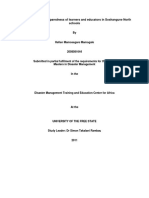0%(1)0% found this document useful (1 vote)
4K viewsAssertion & Reasoning Questions: DIRECTION: in The Following Questions, A Statement of Assertion (A) Is Followed by A
Assertion & Reasoning Questions: DIRECTION: in The Following Questions, A Statement of Assertion (A) Is Followed by A
Uploaded by
Vedyam AcademyThe document contains 11 questions regarding assertions and reasons related to geometry concepts like angles, triangles, parallel lines, and more. For each question, the correct answer is provided by analyzing whether the assertion and reason are true or false, and whether the reason explains the assertion. The questions cover a range of geometry topics and logical reasoning is used to evaluate each assertion and reason statement.
Copyright:
© All Rights Reserved
Available Formats
Download as PDF, TXT or read online from Scribd
Assertion & Reasoning Questions: DIRECTION: in The Following Questions, A Statement of Assertion (A) Is Followed by A
Assertion & Reasoning Questions: DIRECTION: in The Following Questions, A Statement of Assertion (A) Is Followed by A
Uploaded by
Vedyam Academy0%(1)0% found this document useful (1 vote)
4K views12 pagesThe document contains 11 questions regarding assertions and reasons related to geometry concepts like angles, triangles, parallel lines, and more. For each question, the correct answer is provided by analyzing whether the assertion and reason are true or false, and whether the reason explains the assertion. The questions cover a range of geometry topics and logical reasoning is used to evaluate each assertion and reason statement.
Original Title
Lines & Angles
Copyright
© © All Rights Reserved
Available Formats
PDF, TXT or read online from Scribd
Share this document
Did you find this document useful?
Is this content inappropriate?
The document contains 11 questions regarding assertions and reasons related to geometry concepts like angles, triangles, parallel lines, and more. For each question, the correct answer is provided by analyzing whether the assertion and reason are true or false, and whether the reason explains the assertion. The questions cover a range of geometry topics and logical reasoning is used to evaluate each assertion and reason statement.
Copyright:
© All Rights Reserved
Available Formats
Download as PDF, TXT or read online from Scribd
Download as pdf or txt
0%(1)0% found this document useful (1 vote)
4K views12 pagesAssertion & Reasoning Questions: DIRECTION: in The Following Questions, A Statement of Assertion (A) Is Followed by A
Assertion & Reasoning Questions: DIRECTION: in The Following Questions, A Statement of Assertion (A) Is Followed by A
Uploaded by
Vedyam AcademyThe document contains 11 questions regarding assertions and reasons related to geometry concepts like angles, triangles, parallel lines, and more. For each question, the correct answer is provided by analyzing whether the assertion and reason are true or false, and whether the reason explains the assertion. The questions cover a range of geometry topics and logical reasoning is used to evaluate each assertion and reason statement.
Copyright:
© All Rights Reserved
Available Formats
Download as PDF, TXT or read online from Scribd
Download as pdf or txt
You are on page 1of 12
ASSERTION & REASONING QUESTIONS
DIRECTION : In the following questions, a statement of assertion (A) is followed by a
statement of reason (R). Mark the correct choice as:
(a)Both assertion (A) and reason (R) are true and reason (R) is the correct explanation
of assertion (A).
(b)Both assertion (A) and reason (R) are true but reason (R) is not the correct
explanation of assertion (A).
(c)Assertion (A) is true but reason (R) is false.
(d)Assertion (A) is false but reason (R) is true.
1. Assertion : If angles ‘a ’ and ‘b’ form a linear pair of angles and a = 400, then b = 1500.
Reason : Sum of linear pair of angles is always 1800.
(a)Both assertion (A) and reason (R) are true and reason (R) is the correct explanation
of assertion (A).
(b)Both assertion (A) and reason (R) are true but reason (R) is not the correct
explanation of assertion (A).
(c)Assertion (A) is true but reason (R) is false.
(d)Assertion (A) is false but reason (R) is true.
Ans: We know that the sum of linear pair of angles is always 1800.
So, Reason is correct.
Now, a + b = 400 + 1500 = 1900 ≠1800
Hence, Assertion is not correct
Correct option is (d) Assertion (A) is false but reason (R) is true.
2. Assertion : If two interior angles on the same side of a transversal intersecting
two parallel lines are in the ratio 5 : 4, then the greater of the two angles is 1000.
Reason : If a transversal intersects two parallel lines, then the sum of the interior
angles on the same side of the transversal is 1800.
Ans: We know If a transversal intersects two parallel lines, then the sum of the
interior angles on the same side of the transversal is 1800
hat the solution of the line will satisfy the equation of the line.
So, Reason is correct.
Let the angles be 5x and 4x
Since, these two angles are co-interior angles. So, we
have 5x + 4x = 1800 ⇒ 9x = 1800 ⇒ x = 200
Hence, greater angle = 5x = 5 x 200 = 1000
So, Assertion is also correct
Correct option is (a) Both assertion (A) and reason (R) are true and reason (R) is
the correct explanation of assertion (A).
3. Assertion : An angle is 140 more than its complementary angle, then angle is 520.
Reason : Two angles are said to be supplementary if their sum of measure of angles
is 1800.
Ans: We know that two angles are said to be supplementary if their sum of
measure of angles is 1800.
So, Reason is correct.
Let the angle be x . Complement of x = (900 - x)
Since, the difference is 140, we have x – (900 – x) = 140
⇒ 2x = 1040
⇒ x = 520
So, Assertion is also correct
But reason (R) is not the correct explanation of assertion (A).
Correct option is (b) Both assertion (A) and reason (R) are true and reason (R)
is not the correct explanation of assertion (A).
4. Assertion : Supplement of angle is one fourth of itself. The measure of the angle is
1440.
Reason : Two angles are said to be supplementary if their sum of measure of angles
is 1800.
Ans: We know that two angles are said to be supplementary if their sum of
measure of angles is 1800.
So, Reason is correct.
Let the angle be x . Supplement of x = x
0
So, x + x = 1800 ⇒ x = 1800 ⇒ x = 144
So, Assertion is also correct
Also, reason (R) is the correct explanation of assertion (A).
Correct option is (a) Both assertion (A) and reason (R) are true and reason (R)
is the correct explanation of assertion (A).
5. Assertion: The value of x from the adjoining figure, if l || m is 150.
Reason: If two parallel lines are intersected by a transversal, then
each pair of corresponding angles so formed is equal.
Ans: We know that If two parallel lines are intersected by a transversal,
then each pair of corresponding angles so formed is equal.
So, Reason is correct.
Also, we know that If a transversal intersects two parallel lines, then
the sum of the interior angles on the same side of the transversal is
1800.
From figure we have, 1200 – x + 5x = 1800
⇒ 4x = 1800 – 1200
⇒ 4x = 600
⇒ x = 150
So, Assertion is also correct.
But reason (R) is not the correct explanation of assertion (A).
Correct option is (b) Both assertion (A) and reason (R) are true and
reason (R) is not the correct explanation of assertion (A).
6. Assertion : If two internal opposite angles of a triangle are equal and external angle
is given to be 1100, then each of the equal internal angle is 550.
Reason : A triangle with one of its angle 900, is called a right triangle.
Ans: For Assertion: We know that the exterior angle is equal to the sum of its
interior opposite angles. So, x + x = 1100.
⇒ 2x = 1100
⇒ x = 550
So, Assertion is correct
Also, we know that a triangle with one of its angle 900, is called a right
triangle.
So, Reason is also correct.
But reason (R) is not the correct explanation of assertion (A).
Correct option is (b) Both assertion (A) and reason (R) are true and reason (R)
is not the correct explanation of assertion (A).
7. Assertion : Sum of the pair of angles 1200 and 600 is supplementary.
Reason : Two angles, the sum of whose measures is 1800, are called supplementary
angles.
Ans: We know that two angles are said to be supplementary if their sum of
measure of angles is 1800.
So, Reason is correct.
Now, 1200 + 600 = 1800 ⇒ Sum of the pair of angles 1200 and 600 is
supplementary.
So, Assertion is also correct
Also, reason (R) is the correct explanation of assertion (A).
Correct option is (a) Both assertion (A) and reason (R) are true and reason (R)
is the correct explanation of assertion (A).
8. Assertion : A triangle can have two obtuse angles.
Reason : The sum of all the interior angles of a triangle is 1800
(a)Both assertion (A) and reason (R) are true and reason (R) is the correct explanation
of assertion (A).
(b)Both assertion (A) and reason (R) are true but reason (R) is not the correct
explanation of assertion (A).
(c)Assertion (A) is true but reason (R) is false.
(d)Assertion (A) is false but reason (R) is true.
Ans: We know that the sum of all the interior angles of a triangle is 1800.
So, Reason (R) is true.
Since the Sum of two obtuse angles will be more than 1800.
So, Assertion (A) is false.
Correct option is (d) Assertion (A) is false but reason (R) is true.
9. Assertion: The angles of a triangle are in the ratio 2 : 3 : 4. The largest
angle of the triangle is 800.
Reason: The sum of all the interior angles of a triangle is 1800
Ans: We know that the sum of all the interior angles of a triangle is 1800.
So, Reason (R) is true.
Let the angles of a triangle be 2x, 3x and 4x then we have
2x + 3x + 4x = 1800
⇒ 9x = 1800
⇒ x = 200.
Hence, Largest angle = 4 x 200 = 800.
So, Assertion (A) is also true.
Also, Reason (R) is a correct explanation of Assertion (A).
Correct option is (a) Both assertion (A) and reason (R) are true and reason
(R) is the correct explanation of assertion (A).
10. Assertion: In the given figure, AOB is a straight line. If
∠AOC = (3x + 10)° and ∠BOC (4x − 26)°, then ∠BOC = 860
Reason: The sum of angles that are formed on a straight line
is equal to 180°.
Ans: We know that the sum of angles that are formed on a
straight line is equal to 180°.
So, Reason is correct
We have : ∠AOC+∠BOC=180° [Since AOB is a straight line ]
⇒3x + 10 + 4x − 26 = 180°
⇒7x = 196°
⇒x = 28°
∴∠BOC = [4 × 28 − 26]°
⇒∠BOC=86°.
So, Assertion (A) is also true.
Correct option is (a) Both assertion (A) and reason (R) are true
and reason (R) is the correct explanation of assertion (A).
11. Assertion : The angles of a triangle are in the ration 3 : 5 : 7. The triangle is acute-
angled
Reason : The sum of angles that are formed on a straight line is equal to 180°.
Ans: We know that the sum of angles that are formed on a straight line
is equal to 180°.
So, Reason is correct
Also, the sum of all the interior angles of a triangle is 1800
Let the angles measure (3x)°, (5x)° and (7x)°.
Then,3x + 5x + 7x = 180° ⇒15x = 180° ⇒x = 12°
Therefore, the angles are 3(12)°=36°, 5(12)°=60° and 7(12)° = 84°.
Hence, the triangle is acute-angled.
So, Assertion (A) is also true.
But reason (R) is not the correct explanation of assertion (A).
Correct option is (b) Both assertion (A) and reason (R) are true and
reason (R) is not the correct explanation of assertion (A).
You might also like
- Lines and Angles Class 7Document4 pagesLines and Angles Class 7jellybeanvscanman1883% (6)
- Study Material 7th Maths, 2023-24Document120 pagesStudy Material 7th Maths, 2023-24Sanshipyaricca HNo ratings yet
- Natural and Whole Numbers. Assignment-1Document2 pagesNatural and Whole Numbers. Assignment-1RichaBhardwajBhatia100% (5)
- Lines and Angles Maths Assignment Class 9 CBSEDocument2 pagesLines and Angles Maths Assignment Class 9 CBSEgurdeepsarora873860% (5)
- Chopra, 7 Steps To WellbeingDocument18 pagesChopra, 7 Steps To Wellbeingcristidumi-1100% (5)
- The Social Media Hack Guide Updated Feb 19Document19 pagesThe Social Media Hack Guide Updated Feb 19Neev100% (1)
- Okeson: MGMT of TMD & OcclusionDocument30 pagesOkeson: MGMT of TMD & OcclusionSANDEEPNo ratings yet
- Maths X Assertion Reasoning Chapter 06Document16 pagesMaths X Assertion Reasoning Chapter 06puneet mangla50% (6)
- Case Study Based On Algebraic ExpressionDocument1 pageCase Study Based On Algebraic Expression24086No ratings yet
- ASSERTION AND REASON ASSIGNMENT Rational Number Class 8thDocument1 pageASSERTION AND REASON ASSIGNMENT Rational Number Class 8thReeta Singh0% (1)
- CBSE Class 7 Maths Important Questions Chapter 1 - IntegersDocument8 pagesCBSE Class 7 Maths Important Questions Chapter 1 - IntegersK Kr100% (1)
- QUADRILATERALSDocument8 pagesQUADRILATERALSal0% (1)
- Assertion and Reason Questions-Mixed BagDocument2 pagesAssertion and Reason Questions-Mixed Bagwarriorbhav125100% (1)
- Important Questions For CBSE Class 8 Maths Chapter 1Document12 pagesImportant Questions For CBSE Class 8 Maths Chapter 1EktaNo ratings yet
- Case Study Statistics Class 9Document4 pagesCase Study Statistics Class 9darkstarverygoodfighterNo ratings yet
- Maths Class X Periodic Test II Sample Paper 03Document3 pagesMaths Class X Periodic Test II Sample Paper 03hweta173No ratings yet
- Important Questions For CBSE Class 8 Maths Chapter 2Document8 pagesImportant Questions For CBSE Class 8 Maths Chapter 2Ekta0% (1)
- Class 6 - Assertion Reasoning QuestionsDocument3 pagesClass 6 - Assertion Reasoning Questionshawtpotatoooo100% (1)
- CBSE Class 6 Mathematics Higher Order Thinking Questions Chapter-11 AlgebraDocument1 pageCBSE Class 6 Mathematics Higher Order Thinking Questions Chapter-11 Algebrasiba padhy100% (1)
- CBSE Class 8 Mathematics Worksheet - Mensuration PDFDocument3 pagesCBSE Class 8 Mathematics Worksheet - Mensuration PDFsana0% (1)
- 8TH Icse Polygons Revision SheetDocument1 page8TH Icse Polygons Revision Sheetmanojboa67% (3)
- Cl. 7 Ch. 4. Simple Equations WorksheetDocument2 pagesCl. 7 Ch. 4. Simple Equations WorksheetBiju Thomas HPS R100% (1)
- The Triangle and Its Properties (Class 7)Document13 pagesThe Triangle and Its Properties (Class 7)RAJESH JAINAL75% (4)
- CBSE Class 6 Mensuration Worksheet - 4 PDFDocument1 pageCBSE Class 6 Mensuration Worksheet - 4 PDFIhtesham Hussain100% (1)
- CBSE Class 6 Maths Understanding Elementary Shapes WorksheetsDocument3 pagesCBSE Class 6 Maths Understanding Elementary Shapes WorksheetsParth Aggarwal (Parth)No ratings yet
- 9th Math CH Triangle Test PaperDocument1 page9th Math CH Triangle Test PaperJanardan Sunil100% (1)
- Case Study - Chapter 3Document5 pagesCase Study - Chapter 3Nupur Agrawal100% (1)
- Class-IX (Maths) Ch-1 Worksheet (2023-24)Document2 pagesClass-IX (Maths) Ch-1 Worksheet (2023-24)MansiNo ratings yet
- Class-8 Maths Case Study Worksheet (Annual Exam 2023-2024) 2Document2 pagesClass-8 Maths Case Study Worksheet (Annual Exam 2023-2024) 2arjan.singh.sawhney100% (5)
- Class Vii Sample Paper Maths (Algebra) : CBSE Guide Teacher' JobsDocument2 pagesClass Vii Sample Paper Maths (Algebra) : CBSE Guide Teacher' Jobs7A04Aditya MayankNo ratings yet
- Shapes and Angles Class 5 Notes CBSE Maths Chapter 2 (PDF)Document6 pagesShapes and Angles Class 5 Notes CBSE Maths Chapter 2 (PDF)movies 123No ratings yet
- Exponents and Powers Class 7 MCQsDocument16 pagesExponents and Powers Class 7 MCQsTHE FULL CART100% (2)
- Triangles and Its Properties Assignment 10Document2 pagesTriangles and Its Properties Assignment 10siba padhyNo ratings yet
- Class 9 Linear Equations in Two VariableS 2023-24Document2 pagesClass 9 Linear Equations in Two VariableS 2023-24Anshika100% (1)
- CBSE VIII Class Mathematics Pre Mid Term Question PapersDocument4 pagesCBSE VIII Class Mathematics Pre Mid Term Question PapersVIGNESH Y100% (2)
- LINES AND ANGLES Class 9 CBSEDocument8 pagesLINES AND ANGLES Class 9 CBSEriya rajput100% (1)
- QP - PS - CBSE - STD IX - Math - 7 - TrianglesDocument7 pagesQP - PS - CBSE - STD IX - Math - 7 - Trianglespriyanshubairwa97983% (6)
- Cbse Sample Paper Class 7 Mathemtatics Fa 1 With SolutionDocument6 pagesCbse Sample Paper Class 7 Mathemtatics Fa 1 With SolutionSuyashNo ratings yet
- Case Study of Circle (Class 9)Document2 pagesCase Study of Circle (Class 9)rohanrouth32venus100% (1)
- Maths VIII Periodic Test 1 Sample Paper 03 2019Document3 pagesMaths VIII Periodic Test 1 Sample Paper 03 2019nseeker19100% (4)
- CBSE Class 7 Mathematics MCQs Perimeter and AreaDocument2 pagesCBSE Class 7 Mathematics MCQs Perimeter and Areasiba padhy100% (4)
- CBSE Class 6 Maths Understanding Elementary Shapes WorksheetsDocument10 pagesCBSE Class 6 Maths Understanding Elementary Shapes WorksheetsdeekshitaNo ratings yet
- CBSE Class 6 Playing With Numbers Worksheet PDFDocument5 pagesCBSE Class 6 Playing With Numbers Worksheet PDFdoctshind s100% (3)
- Data Handling Class 7 Extra QuestionsDocument3 pagesData Handling Class 7 Extra Questionssuvashree100% (2)
- Class 9th Lines and AnglesDocument4 pagesClass 9th Lines and Angles21CS133 Kumar Gautam Yadav0% (1)
- 9th Lines and Angle Test Paper-2 PDFDocument3 pages9th Lines and Angle Test Paper-2 PDFsudhir_kumar_33100% (4)
- Grade 8 Maths Algebraic Expressions and Exponents MCQDocument4 pagesGrade 8 Maths Algebraic Expressions and Exponents MCQa1b3do100% (1)
- Half Yearly - 8Document3 pagesHalf Yearly - 8Legend CrimeNo ratings yet
- CBSE Class 6 Mathematics (SA-1) Questions Paper 2014-2015: Material Downloaded From - 1 / 7Document7 pagesCBSE Class 6 Mathematics (SA-1) Questions Paper 2014-2015: Material Downloaded From - 1 / 7siba padhyNo ratings yet
- Periodic Test - I Session: 2018-19: Class - IV Subject: MathematicsDocument6 pagesPeriodic Test - I Session: 2018-19: Class - IV Subject: MathematicsRudra DeyNo ratings yet
- Symmetry 5 PDFDocument5 pagesSymmetry 5 PDFVinothini SreedharNo ratings yet
- Mathematics Olympiad For Class 6th 7th 8th Set 1 PDFDocument17 pagesMathematics Olympiad For Class 6th 7th 8th Set 1 PDFRakesh SinghNo ratings yet
- CBSE Maths Lab Manual For Class 6 To 8 Activity 1 To 27 in EnglishDocument66 pagesCBSE Maths Lab Manual For Class 6 To 8 Activity 1 To 27 in EnglishrubabshaikhNo ratings yet
- Grade 9: Herons Formula WorksheetDocument6 pagesGrade 9: Herons Formula WorksheetEduGain100% (4)
- CBSE Class 9 Mathematics Worksheet - CirclesDocument9 pagesCBSE Class 9 Mathematics Worksheet - CirclesmrudulaNo ratings yet
- Class - IX CH-13 Surface Area and Volume (Maths Assignment)Document1 pageClass - IX CH-13 Surface Area and Volume (Maths Assignment)Devansh Kumar X Challengers , 07No ratings yet
- Important Questions For Class 9 Maths Chapter 12 - Heron's FormulaDocument80 pagesImportant Questions For Class 9 Maths Chapter 12 - Heron's FormulaJasmine KaurNo ratings yet
- Class 7 Maths Chapter 10 Practical Geometry Worksheet 2Document5 pagesClass 7 Maths Chapter 10 Practical Geometry Worksheet 2suvashree100% (1)
- CHAPTER 1 - KNOWING OUR NUMBERS PPT 1Document12 pagesCHAPTER 1 - KNOWING OUR NUMBERS PPT 1Archana Ji0% (2)
- Maths Ix Assertion Reasoning Chapter 06Document15 pagesMaths Ix Assertion Reasoning Chapter 06Harshvardhan S. KantimahanthiNo ratings yet
- Maths IX Assertion Reasoning Chapter 07Document16 pagesMaths IX Assertion Reasoning Chapter 07SHARLEN KNIGHTNo ratings yet
- Linear Equations in Two VariablesDocument12 pagesLinear Equations in Two VariablesVedyam AcademyNo ratings yet
- Chapter - 9 Application of TrigonometryDocument5 pagesChapter - 9 Application of Trigonometrysitamm193No ratings yet
- T4 - Đề thi thử THPT Hương Sơn - Hà Tĩnh 2023 (HDG Chi tiết)Document29 pagesT4 - Đề thi thử THPT Hương Sơn - Hà Tĩnh 2023 (HDG Chi tiết)Kie YookNo ratings yet
- SeccapDocument1 pageSeccaplaraibmuhammadsaleemNo ratings yet
- Eight Habits 01Document25 pagesEight Habits 01Lara Grace M. CunananNo ratings yet
- USAN 401 Aout DramaDocument7 pagesUSAN 401 Aout DramamvsseaswarNo ratings yet
- Education 2023 01Document35 pagesEducation 2023 01JohnNo ratings yet
- LogDocument13 pagesLoglukyno452No ratings yet
- Review Mathematics Second Final Test 2023-2024Document7 pagesReview Mathematics Second Final Test 2023-2024lightningthe77No ratings yet
- Conduct ResearchDocument1 pageConduct ResearchKho Kent JohnNo ratings yet
- Fearn, Larry - Charging Documents - Sept 2017Document7 pagesFearn, Larry - Charging Documents - Sept 2017WUSA9-TV100% (1)
- Portfolio Self AssessmentDocument2 pagesPortfolio Self Assessmentapi-284109574No ratings yet
- A Freudian Psychoanalytic Approach To Harold Pinter'S The CaretakerDocument15 pagesA Freudian Psychoanalytic Approach To Harold Pinter'S The CaretakerInder KishanNo ratings yet
- In Fs ICEMA NoexpDocument24 pagesIn Fs ICEMA NoexpG BabuNo ratings yet
- Product Management: Case Study Scene Actors Hoài TrâmDocument3 pagesProduct Management: Case Study Scene Actors Hoài TrâmWoo BinNo ratings yet
- Pellslauren ResumeDocument4 pagesPellslauren Resumeapi-201599837No ratings yet
- Lop 11-PRACTICE TEST - Docx 1Document12 pagesLop 11-PRACTICE TEST - Docx 1tranthaihoang1707No ratings yet
- Fiber Optics PPT 3Document12 pagesFiber Optics PPT 3Srijan pareekNo ratings yet
- Flexibility Analysis of A Bare Pipe Line Used For Cryo ApplicationDocument12 pagesFlexibility Analysis of A Bare Pipe Line Used For Cryo ApplicationksvvijNo ratings yet
- Orientation in PIMAMDocument63 pagesOrientation in PIMAMEunicee ElardoNo ratings yet
- In Vehicle Do IpDocument14 pagesIn Vehicle Do IpKosta1990No ratings yet
- Identity Assimilation and Church Separat PDFDocument464 pagesIdentity Assimilation and Church Separat PDFAndreiMotoraNo ratings yet
- SS1 ChemistryDocument4 pagesSS1 Chemistryibrahimabdulmalik707No ratings yet
- Ôn Tập Unit 4 A. Phonetics and Speaking: Chọn từ có phần gạch chân được phát âm khácDocument8 pagesÔn Tập Unit 4 A. Phonetics and Speaking: Chọn từ có phần gạch chân được phát âm khácPhương Anh NguyễnNo ratings yet
- Advantages and Disadvantages of Using Instructional Materials in Teaching EslDocument2 pagesAdvantages and Disadvantages of Using Instructional Materials in Teaching EslhanitamohdhasnanNo ratings yet
- Offsites Engineering Works For The Erbil Refinery 40,000 B/D Expansion ProjectDocument7 pagesOffsites Engineering Works For The Erbil Refinery 40,000 B/D Expansion ProjectSardar Perdawood100% (1)
- Assessing Disaster Preparedness PDFDocument157 pagesAssessing Disaster Preparedness PDFKs Comaling Paminter100% (1)
- Understanding Metal Stamping - Design To Prototyping To ProductionDocument11 pagesUnderstanding Metal Stamping - Design To Prototyping To ProductionRAKHEE RICHHARIA100% (2)
- Exercise - 03: Miscellaneous Type QuestionsDocument6 pagesExercise - 03: Miscellaneous Type QuestionsAbhishek jainNo ratings yet

























































































